| Article ID | Journal | Published Year | Pages | File Type |
|---|---|---|---|---|
| 5627795 | Clinical Neurophysiology | 2017 | 8 Pages |
â¢Photoparoxysmal EEG responses (PPR) are very common (42%) in patients with Dravet syndrome (DS).â¢PPR in DS occurs at a strikingly young age and seems to be connected with a more severe course.â¢Repetitive intermittent photic stimulation with optimal protocol increases detection rate of PPR.
Objective: To detect determinants for photoparoxysmal EEG response (PPR) in SCN1A-related Dravet syndrome (DS).Methods: Data were studied from nationwide medical histories and EEGs of DS-patients (n = 53; 31 males, age 2-19 years). Detailed questionnaires on visual stimuli were completed by parents (n = 49).Results: PPR was found in 22 patients (42%; median age 1.25 yr), and repeatedly in 17%. PPR (17% of 249 intermittent photic stimulation (IPS)-EEGs) occurred more often with optimal IPS protocols (OR 2.11 [95%CI 1.09-4.13]) and in EEGs showing spontaneous epileptiform abnormalities (OR 5.08 [95%CI 2.05-12.55]).PPR-positive patients tended to be younger at first (p = 0.072) and second seizure (p = 0.049), showed severe intellectual disability (p = 0.042), and had more often spontaneous occipital epileptiform abnormalities (p < 0.001).Clinical sensitivity was reported in medical files in 22% of patients and by parents in 43% (self-induction 24%). Clinical or EEG proven visual sensitivity was detected in 65% of cases.Conclusions: Sensitivity to visual stimuli is very common in DS and more often noticed by parents than confirmed by EEG. Detection of PPR improves with repetitive tests using accurate IPS protocols.Significance: Photosensitivity is an important feature in DS and seems to be a marker of the severity of the disorder. Therefore repeated standardized IPS should be encouraged.
